|
22 (19 in 1851 ) Charlotte Place ) Charlotte Place
Margate
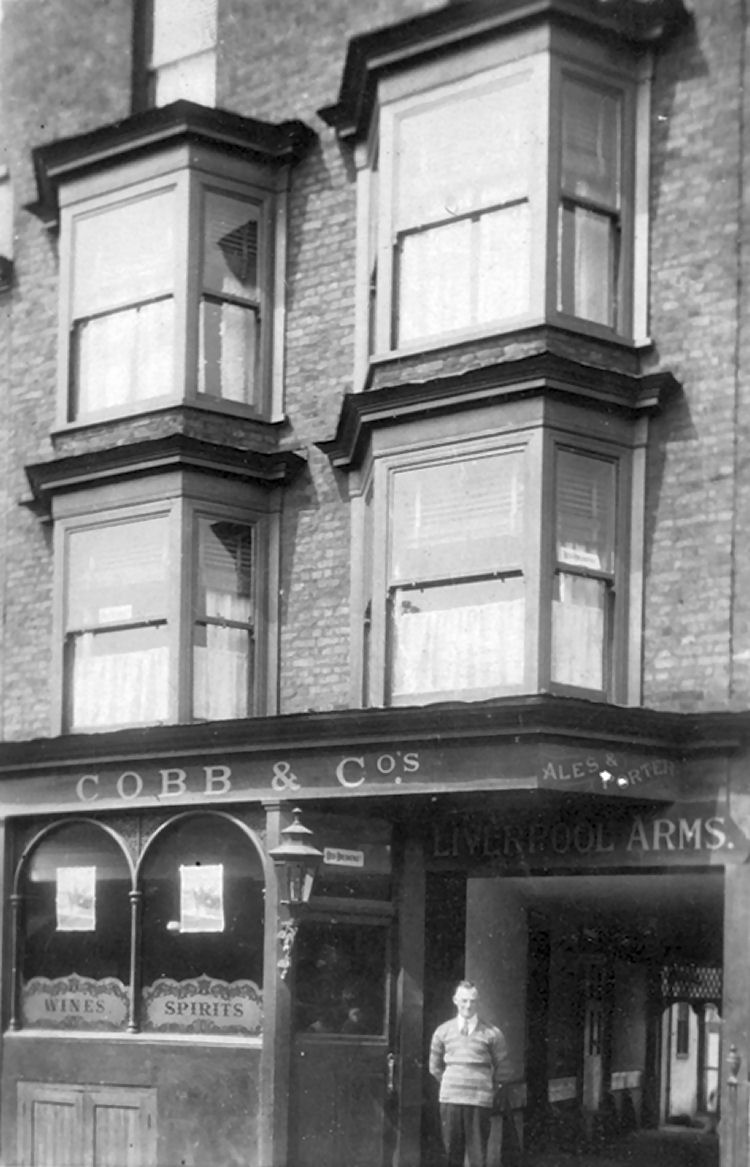
Above photo, date unknown. |
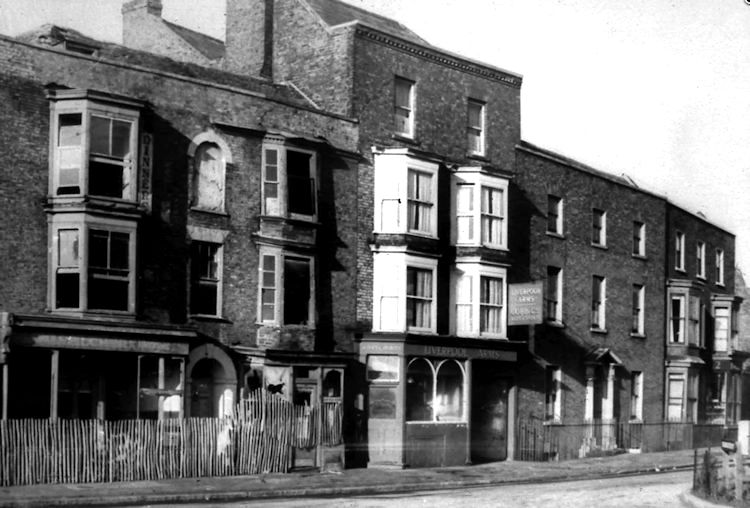
Above photo, date unknown. |

Above photo date unknown.
|
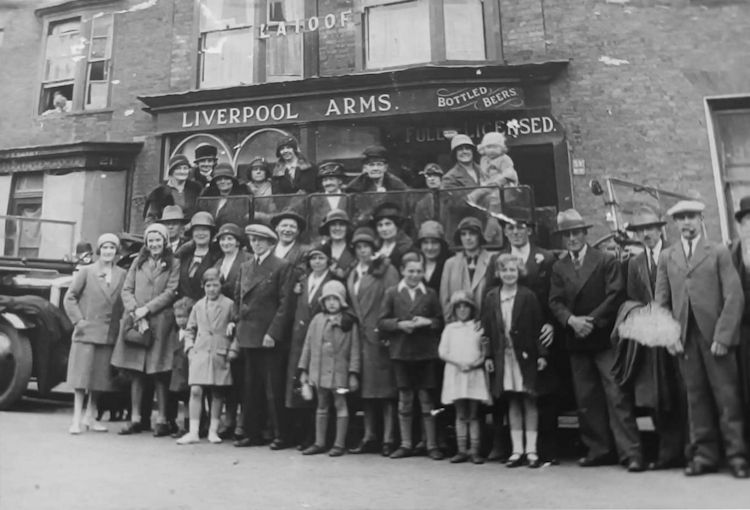
Above photo, showing a outing, date and people unknown. |
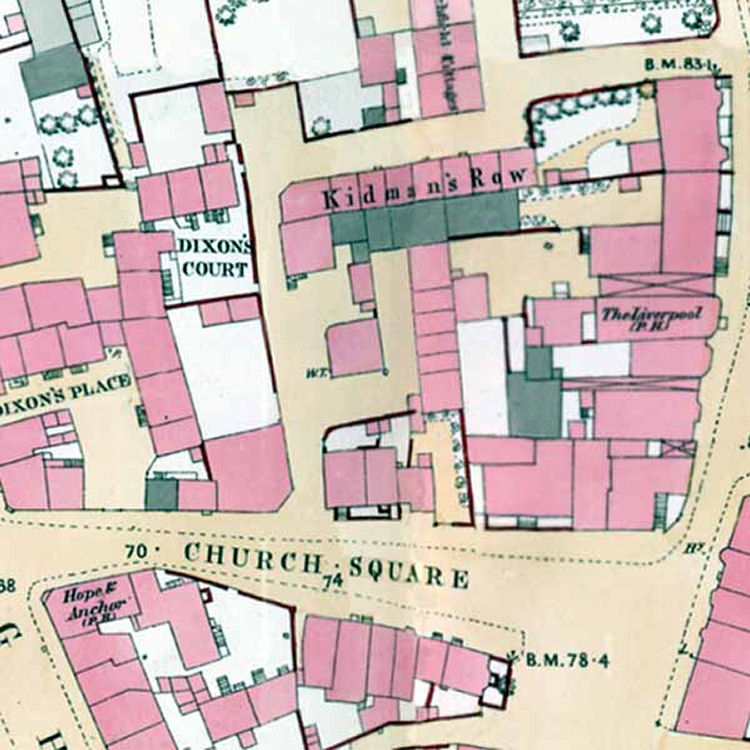
O S Map 1873. |
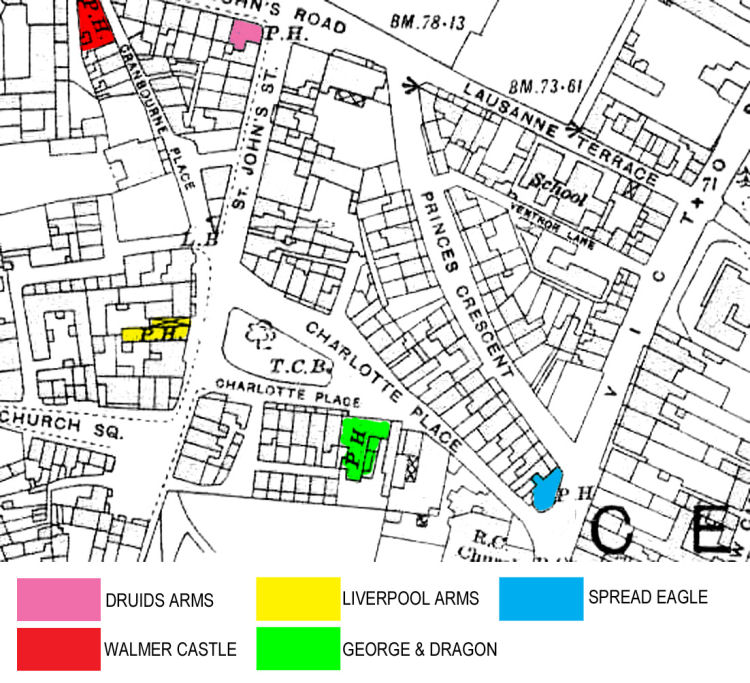
Above map 1948. |
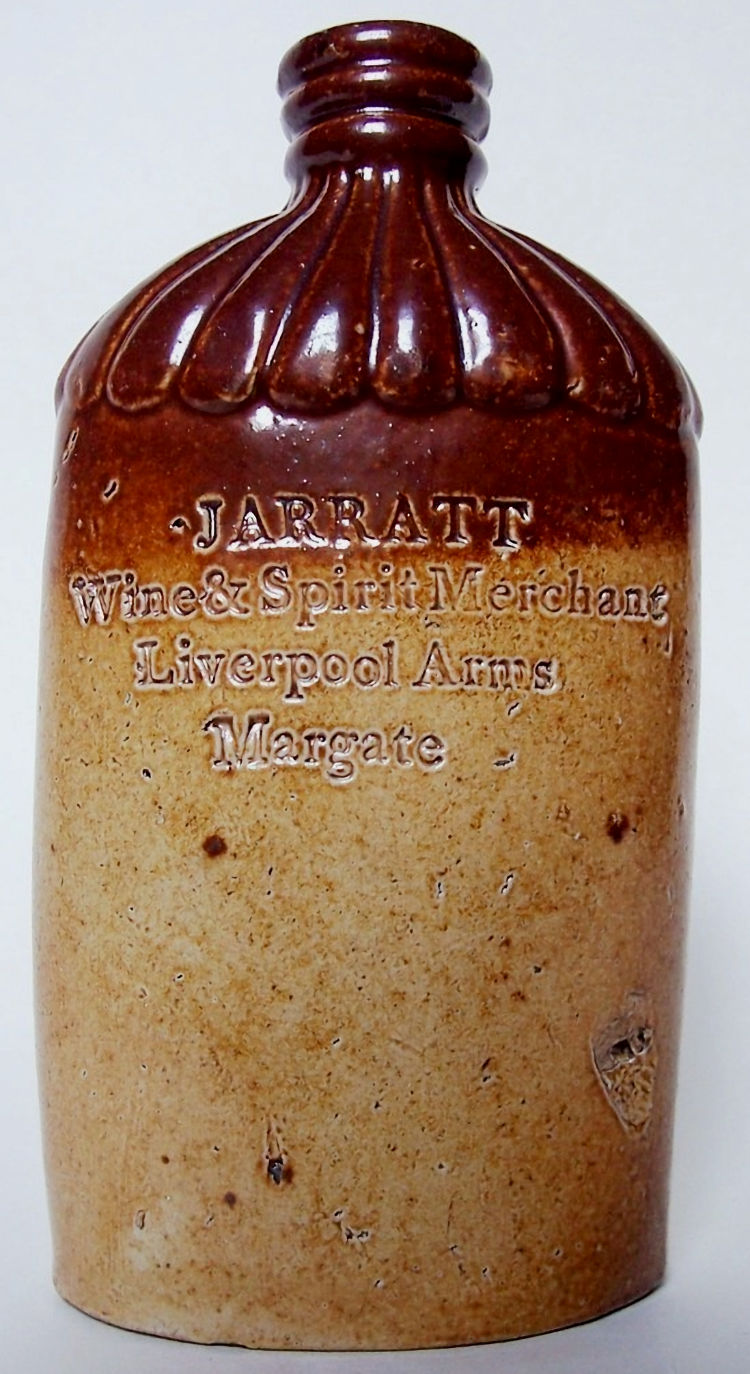
Above ceramic jar, circa 1845, kindly sent by Mary Ault, |
One time Cobbs tied house. Cobbs were founded in 1673, but Whitbread took
them over early 1968 and closed the brewery later that year.
|
Morning Advertiser, Monday 8 August 1831.
JAMES JARRATT, (successor to J. Boncey,)
WINE and SPIRIT-MERCHANT, "Liverpool Arms," Margate,
respectfully
begs to inform the Inhabitants, and Visitors of Margate, and
its vicinity, that he has newly fitted up the above House with every
accommodation, and assures those who may honour him with
their favours, that they may rely on the strictest attention, and
every article on the most reasonable terms. Wines of the best
Vintage,
Genuine Spirits equal to any in the Isle of Thanet, at the lowest
prices. Good Beds and Sitting-rooms for the accommodation of
Visitors. Coaches to Ramsgate ever hour, and to Sandwich, Deal, and
Dovor, every morning at eight, and afternoon at four o’clock.
|
|
From the Kentish Gazette, 13 November 1838.
DEATH.
At Margate, Mr. Jarrett, landlord of the "Liverpool Arms Inn."
|
|
Kentish Gazette, 11 January 1876.
SUSPECTED BRUTAL MURDER AT MARGATE.
Much excitement was occasioned on Sunday last in Margate and the
neighbourhood, by the report that a woman had been most brutally
murdered near the town on the previous night, by a man named Thomas
Fordred, who has been leading a kind of vagabond life for some time
past, often making his appearance before the magistrates on charges
of violence and dishonesty. The victim of what there is too much
reason to believe is a very shocking crime, was an unfortunate woman
named Mary Ann Bridger, who has been living with Fordred for some
time, holding to him in all the vicissitudes of his irregular life,
and sharing his lot through good and evil report. She was 27 years
of age, and her parents, who reside in Margate, are poor but
respectable. The accused man is 41 years of age, and a very sullen
and determined appearance. He is a native of Margate, and has
formerly been in the army. The particulars of the sad occurrence,
as far as they have at present been divulged will be found in the
evidence, taken before the Cinque Ports magistrates at Margate,
yesterday (Monday) morning.
The Magistrates upon the Bench were:- G. E. Hannam, Esq.,
(chairman), H. B. Sheridan, Esq. M.P., K. W. Wilkie, Esq., W. H.
Thornton, Esq., Captain Swinford, and Captain Hatfield.
The prisoner, who had a very callous expression of countenance, was
charged with the wilful murder of Mary Ann Bridger, in the parish of
St. John, Margate. He was not professionally represented.
Superintendent Compton, of the Margate Borough police stated:- On
Saturday night about twenty minutes past eleven, from what
police-constable Stockbridge told me I came to the station. I found
the prisoner there. At one o'clock in the morning of Sunday the
prisoner made this statement to me voluntarily:- "I came into town
at ten minutes past five. I met Mary Ann Bridger and gave her two
half-crowns to pay Mr. Payn, and she had 4 1/2d change out. I took
her to Mr. Austen's in the "New Inn" yard, and had a quart of beer.
She went to Mr. Pamphlett's pork butcher, and bought three pounds of
pork, and brought it to me at Mr. Jezzard's. There I had two 1/2
quarterns of rum and one glass. I went from there to Mr. Jarrett's the
"Liverpool Arms." Mary Ann Bridger, her father and mother, were
there. We had, say two 2 1/2 quarterns of rum. I went there to Mr.
Payn's and got my grocery for the week. From there I was going to
Salmstone. When I came to the bridge she fell down. I pulled her up
and she fell down again. I went and called the waggoner. I told him
I should go to the police and give information that she was dead."
Compton continued:- I went to the barn shortly afterwards
accompanied by Dr, Crawshaw. I found the body of Mary Ann Bridger,
whom I know well, dead, covered with straw. When I took away the
straw, she was naked, with the exception of her stockings. Her age
is 27 years. I came back to the Police-station at five o'clock in
the morning, and charged the prisoner with murdering Mary Ann
Bridger. He said:- "I am not guilty." I took off his
gabardine
(produced) the front of which is covered with blood. His jacket was
also covered with blood. I took his boots off, and the doctor will
give evidence as to their state. I searched prisoner and found on
him a razor, knife, and 9d. in money.
The prisoner said the Superintendent's statement was quite correct,
and he had no questions to ask.
George Emptage, waggoner, said:- The prisoner came to me between ten
and eleven o'clock on Saturday night. I went with him, and found the
deceased Bridger lying on the bank, with her mouth open and her eyes
half shut. I did not hear her speak. I did not see any blood. I
helped to get her on to the back of the prisoner, who carried her.
She was very near naked. I cannot swear whether she was dead or
alive. When I went away from him the prisoner said he thought she
was dead. When prisoner first came to me I noticed blood on his face
and on his coat which he was then wearing.
In reply to the Bench, Mr. Treves, F.R.C.S., said he has seen the
body of the deceased, and was of opinion that death resulted from
violence, but could not tell the exact cause without a post-mortem
examination. On the application of Superintendent Stokes, the Bench
remanded the prisoner till Saturday.
W. H. Payn, Esq., coroner for Dover and its liberties opened an
inquest upon the body of the unfortunate woman at three
o'clock yesterday afternoon at Salmstone Grange and adjourned to
Thursday.
|
|
Kentish Gazette, 18 January 1876.
THE SUSPECTED MURDERAT MARGATE ADJOURNED INQUEST.
The adjourned inquest was held at Salmstone Grange Farm on
Thursday afternoon last, before W. H. Payne, Esq. The first witness
called was Mr. W. K. Treves, F.R.C.S., who deposed as follows:- I
made a post-mortem examination of the body of the deceased Mary Ann
Bridger, and found numerous bruises on the face and bruises on the
collar bone, below the left breast, and on the lower part of the
abdomen. I also found bruises and scratches corresponding in their
appearance to those on the upper part of the chest. I found the
muscles under the bruise on the collar bone torn and pulpified. There
were also bruises on the front of the legs and on the back. On
opening the skull I fund the blood vessels belonging to the
membranes of the brain gorged with blood. The brain was otherwise
healthy. I examined the wind-pipe and throat, and found those
parts uninjured. I opened the chest and found the lungs and heart
healthy. On examining the abdominal cavity I found the membrane
covering the bowels, which is called the peritoneum, bruised in two
places, and blood poured out. In one of these places this membrane
was torn. The other organs were healthy. I consider these combined
injuries sufficient to cause death by shock, and I consider also
that all the injuries, except some of the busies on the face, are
such as might be reduced by kicking. The cold weather might have
been an accelerating cause.
My opinion is that death resulted from those injuries I have
described, and that those injuries were produced by kicks.
Mary Sheaf, wife of Henry Sheaf, a labourer, living at Chapel
Bottom, in the parish of St. John, said:- On Saturday night last I
was returning from Margate, between eight and nine o'clock, perhaps
nearer nine, when I heard a voice near the railway bridge, this side
of it. I came under Tivoli Bridge, and proceeded to the top of the
hill on my way home, when as I got to the top of the hill on my way
home, when as I got to the top of the hill I heard swearing. I was
then standing at the cross roads, at the corner of Salmstone Farm
meadow, when I heard the voice of a man a short distance off say
"You ______ I will do for you." I heard nothing else, but at once
proceeded on my road home to Chapel Bottom.
This being all the evidence, the Coroner proceeded to sum it up to
the jury, after having read the evidence to them. He reminded the
jury that it was simply their duty to enquire when, how, and by what
means the deceased woman Mary Ann Bridger came to her death. They
had heard the evidence of the medical man as to the injuries, and
that of the policeman, who saw Fordred and the deceased out of the
town. The constable said that they were purchasing goods, and that
both were intoxicated at the time. If the jury thought this Thomas
Fordred in coming home suddenly had a quarrel with the woman it was
for them to say whether he was the person who inflicted the injuries
on the deceased. They seemed, according to the description given by
the doctor, to be very brutal injuries, and quite sufficient to
produce death. Their duty was very simple, and it would be for
another court to settle the matter.
The room was cleared for the jury to consult in private, and after
about half-an-hour the Coroner and the public were readmitted, and
the following was announced as the verdict the just had arrived at:-
"That the deceased Mary Ann Bridger died from injuries inflicted
upon her by Thomas Fordred, and that the said Thomas Fordred is
guilty of the manslaughter of the said Mary Ann Bridger." The
Coroner then made out his warrant for the commitment of the prisoner
Thomas Fordred to take his trial at the assizes at Maidstone on a
charge of manslaughter.
At the Town Hall, Margate, on Saturday, Thomas Fordred was brought
up, on remand, on the charge of murdering a woman named Mary Ann
Bridger, with whom he had lived for some time past. The evidence
given by Superintendent Compton on Monday, which contained a
statement made by Fordred on giving information to the police of the
death of the woman, was to the effect that she received the injuries
which caused her death by repeated falls on the stony road, having
been read, George Emptage, a waggoner employed on the farm at
Salmstone Grange, said he was called by the prisoner between ten and
eleven on Saturday night week to assist in carrying the deceased to
a barn on the Grange. He believed she was dead when taken to the
police-station, and informed him the Bridger had met with her death
by repeated falls on the road leading to Salmstone. He caused him to
be detained, and sent for the Superintendent of police (Mr.
Compton), who, on Sunday morning, charged Fordred with the murder of
the woman.
Ann Emptage, the waggoner's wife, deposed that between ten and
eleven on Saturday night, while sitting in her room she heard some
one open a door; but as she supposed it was her husband, she did not
go out. After about three minutes had elapsed, however, she lighted a
candle and went to see what was the matter. She found that some
clothes, similar to those which had been worn by the deceased, were
lying in the washhouse, and also a pudding and some pork. The
prisoner then went to her husband, and later in the night they
returned together to the farm, with what she subsequently found was
the body of the deceased.
Thomas Richard Fuller, a labourer, said that at ten minutes past
eleven he saw the prisoner, who had apparently just returned from
Shalmstone Grange, and noticed that he had some blood on his left
ear. He told him that he was going to inform the police that Bridger
was dead, that she had killed herself by falling about on the road.
William Crump, a coalman, deposed that he was in the
"Liverpool Arms"
at about eight o'clock on Saturday evening. The prisoner and Bridger
were drinking there. Fordred threatened her that if he saw her with
any other men he would knock his brains out and hers also. He also
stated that while there he heard Fordred call the woman his "Daisy,"
"old dear," and used other endearing names.
Police-constable Bradley said that when he was the prisoner and the
woman immediately after they left the previous witness they were
both drunk. he walked with them some distance towards Salmstone
Grange.
Police-constable Bradley said that when he saw the prisoner and the
women immediately after they left the previous witness they were
both drunk. He walked with them some distance towards Salmstone
Grange.
William Brenchley Nash, labourer, said that soon after the previous
witness left the parties he saw the prisoner catch hold of the
woman's clothes and pull her off the path.
Mary Sheaff stated that between eight and nine she was about 100
yards from where it is supposed the deceased met with her death. She
heard a man say, "I will do for you." he appeared to be in a great
rage at the time.
Instructing-constable Stewert, K.C.C., deposed to receiving certain
things from Mrs. Emptage, among them being a broken dish in which
the pudding had been placed on the previous day. It was wrapped in a
handkerchief which was saturated with blood.
Mr. Treves, surgeon, fully described the injuries deceased had
received. he pointed out that great violence had been used, and that
the injuries must have been made by some blunt instrument.
Mr. Treves, surgeon, fully described the injuries deceased had
received. he pointed out that great violence had been used, and that
the injuries must have been made by some blunt instrument.
Other evidence having been given the bench retired for deliberation,
and after an absence of about ten minutes returned into court.
The prisoner was formally charged, and made as statement
substantially the same as the one he made to the police, adding that
his motive for taking her from the left-hand side of the road to the
other was because he thought if he placed her on the high ground he
might get her on his back and carry her to the barn.
The prisoner was then committed for trial at the next Maidstone
Assizes on the charge of murder.
|
|
Kentish Gazette, 21 March 1876.
WEDNESDAY. THE MURDER AT MARGATE.
Before Lord Chief Justice Coleridge.
The whole of the day was occupied up to a late hour with the trial
for murder, in the case of shocking violence to a woman, in which
Lord Coleridge, in a charge of remarkable power, told the jury
distinctly that if they believes the case for the prosecution they
were bound to find a verdict of wilful murder, a verdict which they,
after conviction returned.
Thomas Fordred, a man 48 years of age, was indicted for the wilful
murder of Mary Ann Bridger, at St. John the Baptist, Thanet, on the
8th of January last. He was also charged in the Coroner's
inquisition with manslaughter, but he was tried on the indictment of
murder.
Mr. F. J. Smith and Mr. Avery were for the prosecution; Mr.
Bargreave Deane, at the desire of the Judge, defended the prisoner.
The deceased was a young woman, who lived with her mother at Margate,
and who had from time to time cohabited with the prisoner. He had no
fixed residence, and at times she used to meet him at a farm called
Salmstone Farm, a little out of Margate, and to sleep at a barn
there. At 5 o'clock on the evening of the 8th of January last she
left her mother's house to meet the man. Between 7 and 8 o'clock
they were seen at a shop, and shortly afterwards they were seen again
going out of the town towards the farm. A few minutes afterwards a
witness who passed them in a cart was the man pull the woman off the
pathway. Between 8 and 9 a woman passing along the road near the
meeting of five roads, heard the voice of a man in an angry
threatening tone, and she heard the words, "I'll do for you." No
more was seen or heard of them, until after the woman's death, which
was caused, it was clear, by the violence of some one, between the
spot where they were thus seen and a spot further on, where the body
was found. About 450 ft. from the meeting of the five roads is the
barn belonging to the Salmstone Farm, where a wagonner and his wife
named Emtptage (who knew the woman from seeing here about there)
lived. Mrs. Emptage hearing some on about the premises, and observed
blood upon his coat and face. It was a moonlight night, and she could
see him clearly. The man asked her husband to come with him to help
him to pick up his Poll, who he had left in the road, he said, and
who had killed herself. Emptage went and found the body of the woman
lying by the side of the road, quite dead, in a pool of blood, her
clothes torn off her back, the road for a space of nine yards being
covered with blood and showing evident signs of terrible struggle,
and the face and body showing marks of shocking violence. The body
was almost naked; it had hardly anything on except the stockings;
her clothes being literally torn off her back. The prisoner made
statements to the effect that the woman had killed herself by
throwing herself about when drunk, and this account he said he gave
because he knew the police would be sure to come after him on
account of his having been seen with the woman and blood being upon
his dress. The surgical evidence showed that the woman had sustained
many serious wounds, apparently from kicks. There were several
wounds on the shoulder and the chest, and two marks of kicks upon the
abdomen, with scratches upon the skin (apparently showing that the
body was bare when the kicks ere given), and these blows had caused
ruptures. It was observed that though there were no marks on the
palms of the hands, the backs of the hands were injured as if by
being stamped on. Some hair was found on the spot, which
corresponded
with the woman's. The prisoner's dress and boots were found stained
with blood, and when he was first seen there was blood on his face.
Upon being apprehended, he repeated his statement that the woman had
killed herself by falling about, and that the tearing off her
dress was caused by the efforts to lift her up.
Mr. F. E. Smith, in opening the case for the prosecution, said it
would be for the jury to consider whether there was an atom of truth
in the statements of the prisoner, and whether they were consistent
with the actual facts which would be proved.
On the evidence being begun, one of the jurors said he was unwell
and begged to be excused. He was, he said "nervous" and
subject to
fits, and he had better withdraw at once.
Lord Coleridge upon this directed the juror to withdraw, discharged
the jury, and directed a new jury to be empanelled, allowing the
prisoner his challenges anew. In fact, the old jury were
re-empanelled with the exception of the juror withdrawn, for whom
another was submitted who had heard the case stated, and the trial
then proceeded the first witness not having yet been examined.
Lord Coleridge, in summing up the case to the jury, said it was in
truth an issue of life and death; for upon their verdict it depended
whether the prisoner should be left for a few years longer to pursue
such a life as he might be able to pursue on the face of God's earth,
or whether his life should be cut short by an ignominious death. But
serious as the issue was, they must determine as they would any
other, on the effect of the evidence on their minds. If they were
convinced that the terrible guilt of the crime charged against this
man was brought home to him they must not shrink from saying so, but
f not satisfied of it then they must acquit him of that guilt. They
must not jump to conclusions, or substitute surmise for evidence,
but they must act upon their conviction on the evidence. That the
deceased woman died in the company of the prisoner was clear; that
she died by violence was clear. Did she die through violence
wilfully inflicted by the prisoner? That was the great question in
the case. The deceased woman had been the mistress of the prisoner,
and on this night they were together. The gown the woman wore was
not produced, and had not been found. The mother saw the woman at
half-past 4, and said she was quite sober, and witnesses who saw
them going out of the town, said they seemed drunk, and spoke to
give impressions which indicated that they had had former quarrels.
At a quarter-past 8 they were seen by a witness who spoke to the man
using an angry expression and pulling her off the path, and he said
they were not reeling, and this witness was the last person who met
them together - the last person who saw the woman alive. The next
witness was the woman who, about a quarter to 9, heard the voice of
a man in the road near the place exclaiming, "I'll do for you," and
heard the sound of scuffling. That was the only time when the
prosecution suggested that the deadly attack commenced. It might be
so certainly, but it might not be so, and there was nothing in the
nature of the evidence to point to the inference that it was the
prisoner who was heard. But then came other evidence that it was the
prisoner who was heard. But then came the other evidence which
presented the most important part of the case, the evidence of the
Waggoner and his wife, and the police. Some one about half-past 10
brought to the Waggoner's door some clothes which were part of the
clothes which the poor woman had worn. But for the statements made
by the prisoner three times over, his counsel might have statements
made it clear that he must have brought them, for he admitted that
the woman met her death in his company, and that in his company her
clothes came off, and no one was present but he, so that the
conclusion was inevitable that he was the person who brought them.
What effect that had upon the mind with reference to the account he
gave? The poor woman was lying naked and dead on the snow in a lane,
and the first thing he does is to gather up the outside premises of
the cottage. Then the prisoner carried the dead body all the way to
the barn and did not (the witness said) reel more than a little. If
that were so, then it was vain to contend that he was in such a
state of drink as not to be able to commit the act of violence
attributed to him. There was also blood upon his face and dress.
That was one of the most serious parts of the case against the
prisoner. He was the only person with her person. He was capable of
carrying her; was he not capable of killing her? Did he kill her?
What would be the natural conduct of a person who had no hand in her
death? What was the language the prisoner used in speaking of the
shocking event? He might be destitute of the ordinary feelings of
humanity, and yet not guilty of murder. There was blood upon him,
and the policeman at once asked if there was blood upon his hands. He
would not comment upon the language used by the prisoner, and after
all there came the one "touch of nature." "I found she was cold and
dead. I kissed her lips and left her." There was the account which
fixed him with being present at the time of her death, and the jury
must judge what construction they put upon such conduct and such
language. The witness who saw him at this time said that, though he
had been drinking, yet at that time he was not withstanding when it
was suggested that he was so drunk that he did not know what he was
about. He was capable of making that long statement - of the truth
or credibility of which the jury must judge.
Mr. Deane interposed to observe that his argument had been, not that
the prisoner was to drunk to know what he was about, but that he was
too drunk to have the deliberate intent to kill.
Lord Coleridge, however, as to that, said he must as that it was not
material, assuming that the prisoner committed these acts of
violence. The prisoner, be it observed, had made four different
statements, and one of them was written down from his lips and
signed by him. Anything more deliberate - true or false- never was
done. And the jury must judge whether the state of drunkenness
suggested was consistent with such clear, deliberate statements.
Then as to the truth of falsehood of these statements, they must
contrast the account given by the prisoner with the account of the
poor woman's state as detailed by the doctor. She sell down, he
said, twice or thrice; that is all; not a word as to falling o her
knees, as had been suggested. Then there were the undoubted facts
that the woman died in the presence and with the injuries described
by the witnesses, and especially the doctor. There were two large
wounds on the back of the head into which the witness could put his
finger. There were marks of nails (of boots) on her chest. There
were other injuries discovered, more particularly by the doctor. The
body was naked; there was a wound on the right temple and another
over the eyebrow, the lip cut open, and teeth loosened; two scalp
wounds on the back of the head two inches in diameter; all the wounds
of a bruised and jagged character. "The hands were bruised on the
back, but no injury on the palms - it looked as if the hands had
been trodden upon." That was most remarkable and deserving of
serious attention. On a post-mortem examination there were found
other injuries, which the doctor described. It must have been great
violence, he said, to have caused the injuries. They seemed to be
caused by a thick boot, with large nails; they could not have been
caused by a fall; it would have been required great violence to cut
the lip and loosen the teeth. There were bruises below the breast
and on the hip and thighs and on the front of the legs; there were
ruptures in the abdomen, arising from the blows which caused the
bruises. Such injuries, he said, could not have been caused only by
falling down. Now, it was for the jury to compare this state of the
body and the aspect of the spot where it was found with the account
given by the prisoner. There were the marks upon the spot - he would
not say of a struggle - but of moving about; and the witnesses said
there were marks of blood, and one witness said "pools of blood."
When the prisoner brought the body it was dead - she had been lying
there long enough to bleed so much as to leave behind "pools of
blood," and the account given by the prisoner was that she fell
down
two or three times. The jury must judge for themselves whether this
was true. There were no limits to the range of possibilities, but the
jury were bound to act on the reasonable result of the evidence
before them. Was it reasonably possibly that the wounds could be
caused by falling down twice or thrice on the road - wounds in the
head large enough to put the fingers in, rupture of the abdomen,
bruises and wounds all over the body, the clothes torn off the back,
and all this caused by two or three falls? Such was the story the
jury were asked to believe. But they must proceed upon principles of
common sense and not substitute surmises for the result of evidence.
Probabilities were necessarily acted upon the affairs of life, and
the question was whether here there was not a strong moral reality
that the prisoner was guilty of the crime charges. It had been
suggested that they should find a verdict of manslaughter; but the
prisoner had never suggested that was necessary to grant such a
verdict upon. He had never suggested a quarrel and a fight; and he
was bound to say that, in his view, the only verdict for them were
the first and the third - wilful murder or not guilty. If they
believed the prisoner's story then he was not guilty; if they did
not believe it, then he was guilty of wilful murder. gentlemen (said
his Lordship in conclusion), the case is of immense importance. To
the prisoner, of course, it is of immense importance - it is an
issue of life or death. But to me, I confess, greater importance as
affecting the integrity of trial by jury, and the trust we must all
of us put in the absolute faith and honour of the 12 men to whom the
Constitution in trusts in cases of this kind the decision of these
dread issues. To you I leave this issue, reminding you again that
you have a solemn duty to perform, and I have confidence that you
will perform it.
The jury at six o'clock retired to consider their verdict, and after
an absence of about a quarter of an hour returned into court with a
verdict of "guilty."
The prisoner being called upon to say why sentence of death should
not be passed upon him, said he had nothing to say.
Lord Coleridge then proceeded to press upon him in most impressive
terms the last dread sentence of the law. He said:- You have been
found guilty, after a careful and patient trial, of the greatest
crime of which a human being is capable, and for that not I, but the
law, through me, says that you must die. I will use but the simplest
and shortest and fewest words I can. It is no part of my duty to add
to the terror and the misery which must now invest you. You took the
life of one to whom you were bound by ties of the closest relations;
you took it cruelly, savagely, and without pity and without remorse.
You sent her unmercifully from this world to another. The law is more
merciful to you than you were to your victim. How you may stand with
that ineffable Being before whom we must all one day appear it is
not for me to imagine or suggest. To Him and to His infinite mercy I
must now leave you. I have to pass upon the sentence of the law,
which is, that you be taken to a place of execution and there hanged
by the neck until you are dead, and may Almighty God have mercy on
your soul!
|
|
|
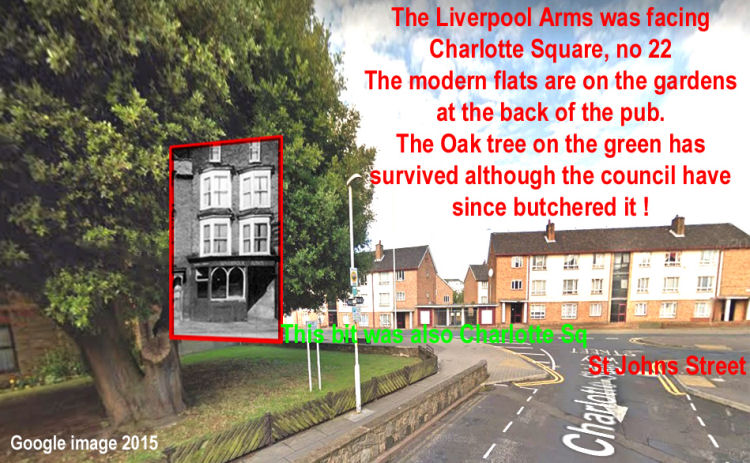
Above amalgamation of photos kindly sent by Debi Birkin. |
LICENSEE LIST
BONCEY John 1823-26+
JARRATT James 1831-Nov/38 dec'd

JARRATT Ann 1839-51+ (age 60 in 1851 ) )

JARRATT Charles 1858-76+ (age 41 in 1871 ) )
GRANT Alfred 1881-82+ (age 24 in 1881 ) )
TAYLOR Albert Edward 1890+
DEVERSON Alfred J 1891+ (age 31 in 1891 ) )
WOODWARD Leonard 1901-03+ (age 26 in 1901 )
("Liverpool Inn") )
("Liverpool Inn")

HICKSON Louisa Harriett 1911+ (age 52 in 1911 ) )
RILEY George 1913+
HOLMAN Walter Freeman 1922+
LODER George 1930+
STEAD P E 1938+
https://pubwiki.co.uk/LiverpoolArms.shtml
http://www.closedpubs.co.uk/liverpoolarms.html
 From the Pigot's Directory 1832-33-34 From the Pigot's Directory 1832-33-34
 From the Kelly's Directory 1903 From the Kelly's Directory 1903
 Census Census
 From
Isle of Thanet Williams Directory 1849 From
Isle of Thanet Williams Directory 1849
|







